|
Ralph Edwards, Broadcasting Pioneer
|
Close
|
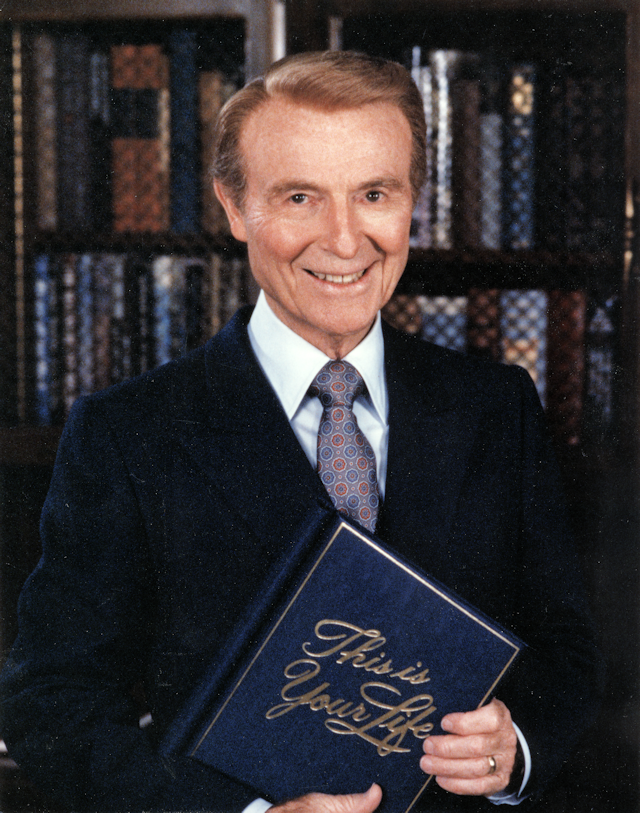 He was the son of pioneers, born in the days when newspapers were the only form of mass media. In a career that spanned nine decades,
he would parley the games he played in the farmhouse front parlor into radio and television perennials that not only entertained millions
for generations, but also significantly impacted for the better the fortune and lives of his country and his fellow man.
He was the son of pioneers, born in the days when newspapers were the only form of mass media. In a career that spanned nine decades,
he would parley the games he played in the farmhouse front parlor into radio and television perennials that not only entertained millions
for generations, but also significantly impacted for the better the fortune and lives of his country and his fellow man.
Ralph Edwards was born near Merino, Colorado on Friday, June 13, 1913, moving with his family to Oakland, California when he was 12.
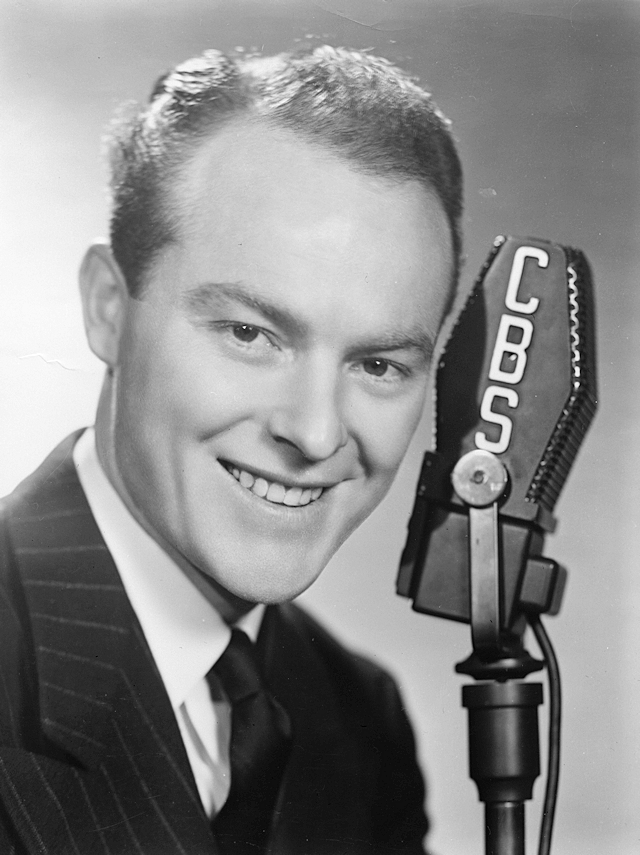 He started in broadcasting as a writer, actor, announcer, and producer at radio station KROW, Oakland in 1929 while still in high school.
He worked his way through college at radio stations in Oakland and San Francisco, graduating from the University of California at Berkeley
in 1935. Edwards moved to New York the following year and became one of radio's busiest announcers, doing as many as 45 network shows a
week on both CBS and NBC. In 1940, in response to this hectic pace, Edwards created, produced and hosted the landmark audience participation
show Truth or Consequences. (Despite his workload, he had been able to meet, woo and wed the former Barbara Jean Sheldon in 1939.)
He started in broadcasting as a writer, actor, announcer, and producer at radio station KROW, Oakland in 1929 while still in high school.
He worked his way through college at radio stations in Oakland and San Francisco, graduating from the University of California at Berkeley
in 1935. Edwards moved to New York the following year and became one of radio's busiest announcers, doing as many as 45 network shows a
week on both CBS and NBC. In 1940, in response to this hectic pace, Edwards created, produced and hosted the landmark audience participation
show Truth or Consequences. (Despite his workload, he had been able to meet, woo and wed the former Barbara Jean Sheldon in 1939.)
Premiering March 23, 1940 on the regional CBS New England Network, Truth or Consequences became so popular so quickly that NBC (which had
originally passed on the show) bought it as a nationwide program, with their inaugural broadcast on August 17, 1940. The program would soon
become radio's No. 1 audience participation show. As its host, Edwards asked contestants
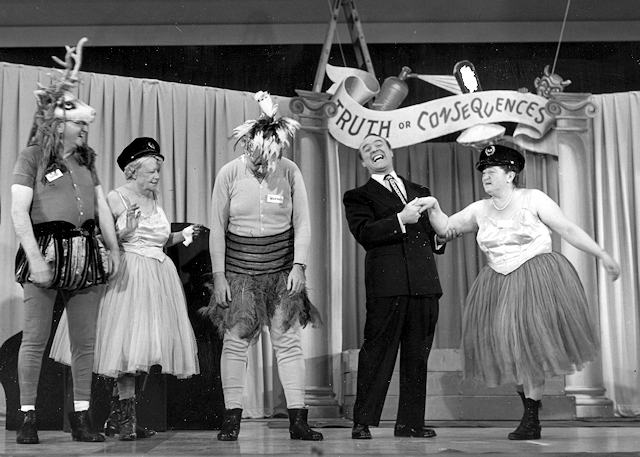 humorous questions and made them "pay the consequences"
for missed answers by performing unusual and often elaborate and outlandish stunts.
humorous questions and made them "pay the consequences"
for missed answers by performing unusual and often elaborate and outlandish stunts.
A special Truth or Consequences TV show was among the handful of programs aired on the very first day of commercial television broadcasting
in the United States, when New York City experimental station W2XBS changed its call letters to WNBT (now WNBC) on July 1, 1941.
Truth or Consequences is also credited with a number of other entertainment "firsts": It was the first to go out of the studio to produce
outrageous stunts on remote; the first to stage surprise reunions; and the first series to combine entertainment with a greater cause.
These ideas became the springboard for later programs and inspired many of today's game and reality shows.
A true patriot in the very best sense of the word, Edwards was among the first to realize the power of radio during World War II. Many
of the show's acts had a tie-in to the war effort, and in an amazing series of Bond tours, Edwards took Truth or Consequences on the road,
covering 100,000 miles to raise half a Billion dollars in E Bonds - the equivalent of almost 6 Billion dollars today. For this he received
a Distinguished Service Citation from the U.S. Treasury Department in 1945, and in 1951 he was presented with a Special Citation as the top
Bond salesman in the nation.
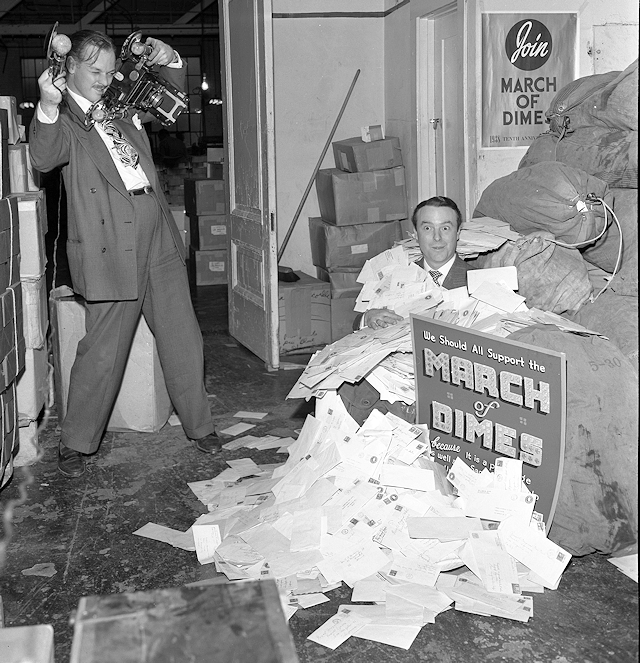 Edwards created a mystery celebrity contest with a pyramiding jackpot of prizes in December 1945 as a parody of the then-current radio
contest craze. It generated so much interest that Ralph realized he had another powerful fundraising vehicle for charity. The March of
Dimes was a frequent beneficiary of these contests, as were the Mental Health Drive and the National Arthritis and Rheumatism Foundation.
Of special significance was the "Walking Man" contest with Jack Benny in 1948. The incredible $1,639,000 contributed by Ralph's listeners -
over $14.6 million today - launched the American Heart Association as a national organization.
Edwards created a mystery celebrity contest with a pyramiding jackpot of prizes in December 1945 as a parody of the then-current radio
contest craze. It generated so much interest that Ralph realized he had another powerful fundraising vehicle for charity. The March of
Dimes was a frequent beneficiary of these contests, as were the Mental Health Drive and the National Arthritis and Rheumatism Foundation.
Of special significance was the "Walking Man" contest with Jack Benny in 1948. The incredible $1,639,000 contributed by Ralph's listeners -
over $14.6 million today - launched the American Heart Association as a national organization.
A 1946 act had "consequences" far beyond what anyone could have dreamed at the time. At the request of General Omar Bradley, then head of
the Veteran's Administration, Edwards came up with an act that showcased the plight of
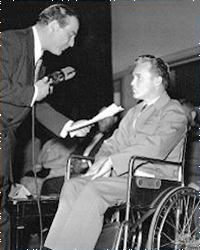 returning veterans who had been injured during the war. Lawrence Tranter, paralyzed from the waist down after being wounded in battle, was selected to appear as a contestant; his consequence
was to relive his past. Ralph presented his "life," with friends and family entering one by one as the narrative unfolded. He then invited
Tranter to attend the Bulova School of Watchmaking, which had been recently established to teach a craft to disabled veterans. Tranter
returned to Truth or Consequences two years later for the presentation of his diploma and all that went with it, including a fully stocked
store and a year's paid rent. It was on that show that Ralph Edwards first spoke the words, "This is your life." Fan mail poured in following
both broadcasts, and Edwards had created a whole new entertainment format.
returning veterans who had been injured during the war. Lawrence Tranter, paralyzed from the waist down after being wounded in battle, was selected to appear as a contestant; his consequence
was to relive his past. Ralph presented his "life," with friends and family entering one by one as the narrative unfolded. He then invited
Tranter to attend the Bulova School of Watchmaking, which had been recently established to teach a craft to disabled veterans. Tranter
returned to Truth or Consequences two years later for the presentation of his diploma and all that went with it, including a fully stocked
store and a year's paid rent. It was on that show that Ralph Edwards first spoke the words, "This is your life." Fan mail poured in following
both broadcasts, and Edwards had created a whole new entertainment format.
This Is Your Life debuted live on NBC Radio in 1948. In its two radio seasons, Ralph presented an incredible cross section of the American
people - from a 19-year-old Ice Follies skater to a 100-year-old veteran of the Civil War.
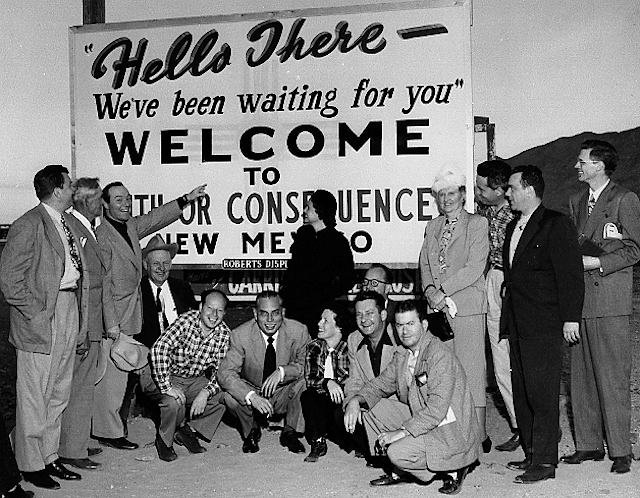 Now he had two hit shows on the air. Edwards' fertile imagination, assisted by the small team of writers he assembled over the years, led
to bigger and bigger things - including sending a contestant across the country to gather signatures for the petition that secured the
postmark for Hollywood, California. Contestants were dispatched to France, Turkey and the Arctic Circle to pay their consequences. One
of Torch's biggest stunts took place in honor of the show's tenth anniversary when the town of Hot Springs, New Mexico voted to change its
name to Truth or Consequences, NM.
Now he had two hit shows on the air. Edwards' fertile imagination, assisted by the small team of writers he assembled over the years, led
to bigger and bigger things - including sending a contestant across the country to gather signatures for the petition that secured the
postmark for Hollywood, California. Contestants were dispatched to France, Turkey and the Arctic Circle to pay their consequences. One
of Torch's biggest stunts took place in honor of the show's tenth anniversary when the town of Hot Springs, New Mexico voted to change its
name to Truth or Consequences, NM.
After a decade on radio with NBC and sponsor Procter & Gamble, Ralph took the opportunity to do both radio and television on CBS, where the
TV series won the first Emmy ever awarded to an audience participation program. Here Ralph helped develop one of TorC's most important
innovations: it was the first television program regularly filmed live before an audience on 35mm film using multiple cameras, pioneering
a technique still used to this day.
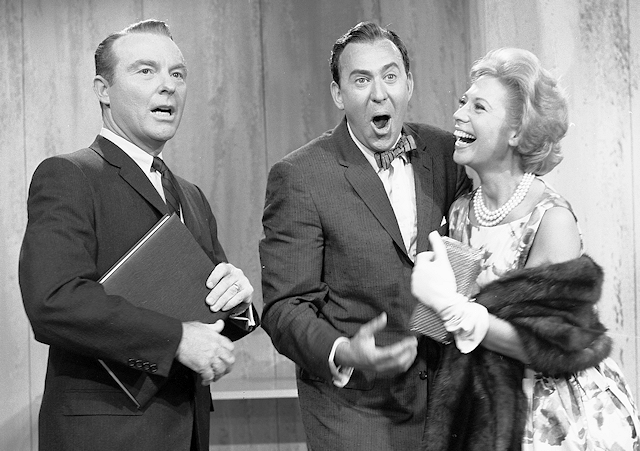 Though 1952 found Edwards back on NBC radio with Truth or Consequences, he also introduced, as creator and host, two new programs to American
television on NBC. January saw The Ralph Edwards Show. One of the first daytime variety programs, it was a combination of music, skits, comedy,
contests, and TorC-type acts. Then, in the fall, This Is Your Life debuted on NBC-TV, where it quickly became an icon of popular culture.
Truly a groundbreaking program, it presented one of the first stories of a Holocaust survivor on network television as well as the only live
U.S. TV appearance of legendary film comedy team Laurel & Hardy.
Though 1952 found Edwards back on NBC radio with Truth or Consequences, he also introduced, as creator and host, two new programs to American
television on NBC. January saw The Ralph Edwards Show. One of the first daytime variety programs, it was a combination of music, skits, comedy,
contests, and TorC-type acts. Then, in the fall, This Is Your Life debuted on NBC-TV, where it quickly became an icon of popular culture.
Truly a groundbreaking program, it presented one of the first stories of a Holocaust survivor on network television as well as the only live
U.S. TV appearance of legendary film comedy team Laurel & Hardy.
Other episodes addressed alcoholism and mental illness when those subjects were still considered taboo. Movie and TV stars, pioneers, artists,
inventors, musicians, scientists, immigrants and refugees, journalists, humanitarians, athletes, educators - all these and more were honored,
one half-hour at a time. Much as he did with Truth or Consequences,
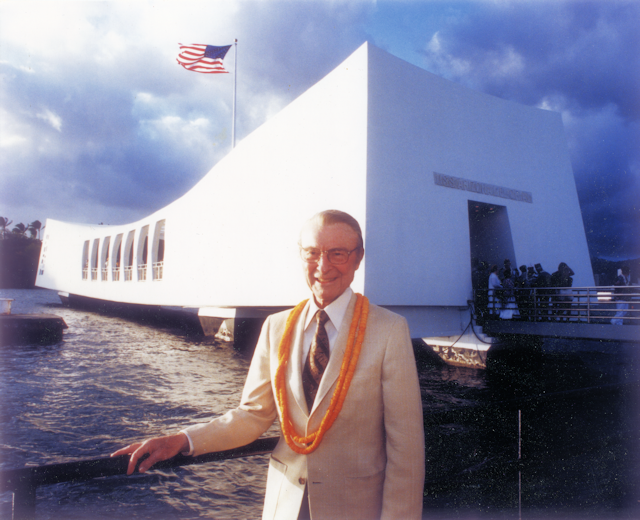 Edwards used This Is Your Life to promote worthy causes as well as to
entertain. The audience responded by contributing to numerous charities, from the March of Dimes to medical aid for Hiroshima survivors.
Viewers helped endow schools and build hospitals. They also provided the first significant donations for the USS Arizona Memorial in Pearl
Harbor, Hawaii, a project launched nationally on the show.
Edwards used This Is Your Life to promote worthy causes as well as to
entertain. The audience responded by contributing to numerous charities, from the March of Dimes to medical aid for Hiroshima survivors.
Viewers helped endow schools and build hospitals. They also provided the first significant donations for the USS Arizona Memorial in Pearl
Harbor, Hawaii, a project launched nationally on the show.
During its nine-year network run Ralph hosted every show but two; when he had minor surgery in early 1957, he asked his friend, an actor by
the name of Ronald Reagan, to fill in.
The demands of a live television show like This Is Your Life, in addition to his duties as creator and producer of TV game show Place the
Face, prompted Edwards to turn to Jack Bailey to carry on with Truth or Consequences in 1954.
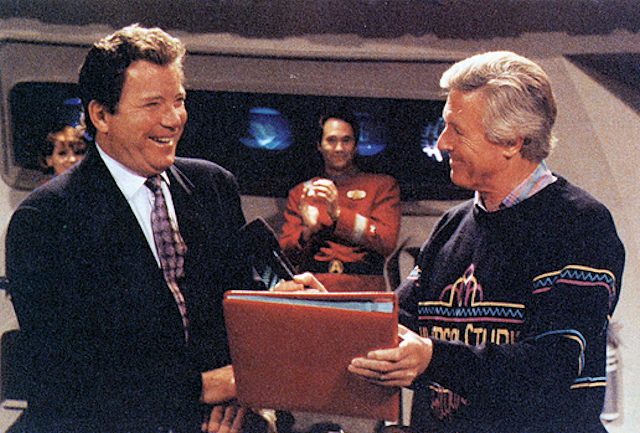 This Is Your Life was soon to become an international institution. Ralph traveled to England in 1955 to host a This Is Your Life special
on BBC-TV, which began its own version of the show that fall. It, too, aired for nine years, and, after a five-year hiatus, returned for
an additional - and remarkable - 34-year run, first on Thames Television, then back on the BBC. The format has also been licensed in many
other countries around the world.
This Is Your Life was soon to become an international institution. Ralph traveled to England in 1955 to host a This Is Your Life special
on BBC-TV, which began its own version of the show that fall. It, too, aired for nine years, and, after a five-year hiatus, returned for
an additional - and remarkable - 34-year run, first on Thames Television, then back on the BBC. The format has also been licensed in many
other countries around the world.
Edwards created and produced several other shows during the next few years: Funny Boners, a children's version of Truth or Consequences
with host Jimmy Weldon in 1954; the elaborately-formatted audience participation show It Could Be You with Bill Leyden in 1956; and the
human-interest program End of the Rainbow, usually hosted by Art Baker, in 1958. The most enduring legacy from this period was the young
man Edwards heard on his car radio and invited to be the new host of a daytime, five day a week version of Truth or Consequences: Bob
Barker, whom Ralph Edwards presented to the NBC-TV audience on the last day of 1956.
Running in tandem with Barker's daytime show, actor Steve Dunne emceed a weekly primetime version of Truth or Consequences in 1957 and
1958, also on NBC.
ABC aired the Edwards-created audience participation show About Faces with host Ben Alexander (1960-1961), and CBS carried his human-interest
show Who in the World with host Warren Hull in 1962. That program focused on people in the news, often resulting in an unusual or emotional
reunion, and was cancelled at the request of the head of CBS News, Fred Friendly, who told Ralph he couldn't do news on an entertainment show!
Edwards partnered with Hal Hudson to produce Wide Country for NBC (1962-1963). The hour-long weekly drama followed the adventures of a
champion rodeo rider as he and his brother traveled the circuit, and starred Earl Holliman and Andrew Prine.
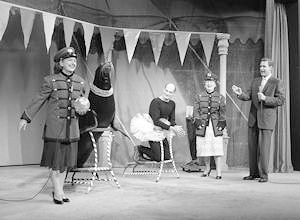 Meanwhile, Bob Barker continued his long run with Truth or Consequences. The show moved to syndication in 1966, where it would continue
to be seen five days a week until 1977.
Meanwhile, Bob Barker continued his long run with Truth or Consequences. The show moved to syndication in 1966, where it would continue
to be seen five days a week until 1977.
A high point was reached in 1967, when programs created by Ralph Edwards filled 10½ hours of TV broadcasting each week. Besides Truth
or Consequences, two other shows carried his banner: the Woody Woodbury Show, a daily 90-minute interview and variety show hosted by the
comedian/musician; and the celebrity-focused game show Let's Face It, which aired only on ABC's WBKB-TV in Chicago and was hosted by It
Could Be You's Bill Leyden.
While a few of the NBC This Is Your Life episodes were originally broadcast in color, the earliest color "Lives" that can be seen today
are from the syndicated revival of the show in 1971. The shows Edwards hosted from this period were all pre-taped, and include the most
exotic locale in the program's history when Edwards and his staff traveled to Brazil to surprise Mary Martin.
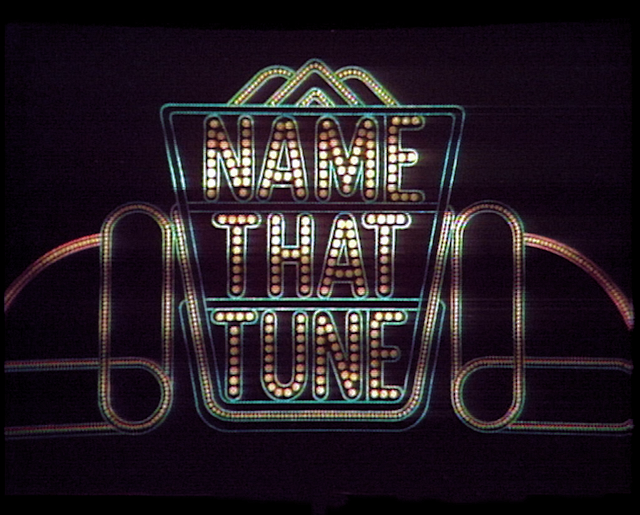 Edwards' only revival of someone else's creation began in 1974 with the musical game show Name That Tune, which aired on NBC and in
syndication in both daytime and nighttime versions, sometimes concurrently. Kathie Lee Johnson (later Kathie Lee Gifford) and Steve
Marsh (son of Mel Torme) were among the singers. The $100,000.00 jackpot the show later offered was the largest at the time.
Edwards' only revival of someone else's creation began in 1974 with the musical game show Name That Tune, which aired on NBC and in
syndication in both daytime and nighttime versions, sometimes concurrently. Kathie Lee Johnson (later Kathie Lee Gifford) and Steve
Marsh (son of Mel Torme) were among the singers. The $100,000.00 jackpot the show later offered was the largest at the time.
Long-time Truth or Consequences writer Jerry Payne was the creator of the comedy game show the Cross-Wits, which Edwards produced in
syndication from 1975-1980 with host Jack Clark. Truth or Consequences itself returned in 1977 as the syndicated New Truth or
Consequences with emcee Bob Hilton, and NBC-TV featured Laugh-In's Arte Johnson as host of the game show Knockout, created by Mark
Maxwell-Smith.
Two items of significance took place in 1981, one that paid tribute to the past, and another that set a course for the future.
NBC-TV aired the This Is Your Life 30th Anniversary Special with host David Frost, featuring profiles of the lives of Charlton
Heston and Rodney Dangerfield as well as a retrospective segment in which Edwards discussed the show's highlights and pitfalls.
The year also saw the first brainchild of the collaboration between Ralph Edwards and producer Stu Billett with the debut of the
reality drama show The People's Court, which has since become a trendsetter and cultural icon.
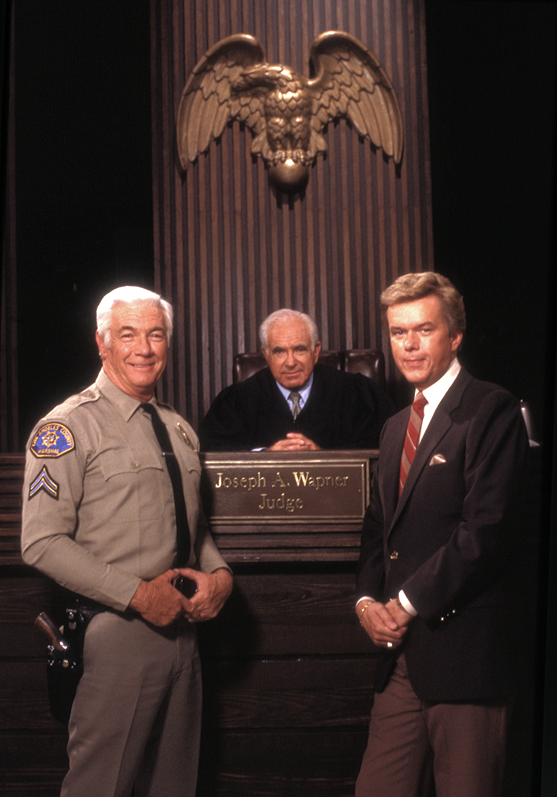 Taped in a courtroom set before a live gallery, the show highlights real small claims court cases, set before, and adjudicated by,
a real judge. The first Judge, Joseph Wapner, with Bailiff Sgt. Rusty Burrell and host Doug Llewelyn, presided over The People's
Court for 12 years. Former New York Mayor Ed Koch, the Hon. Jerry Sheindlen, and the Hon. Marilyn Milian have carried on in his
footsteps.
Taped in a courtroom set before a live gallery, the show highlights real small claims court cases, set before, and adjudicated by,
a real judge. The first Judge, Joseph Wapner, with Bailiff Sgt. Rusty Burrell and host Doug Llewelyn, presided over The People's
Court for 12 years. Former New York Mayor Ed Koch, the Hon. Jerry Sheindlen, and the Hon. Marilyn Milian have carried on in his
footsteps.
The partnership with Stu Billett has produced a number of other syndicated television programs: the human-interest comedy interview
show So You Think You Got Troubles?! featuring ventriloquist Jay Johnson and his wooden partner Bob in 1982; the courtroom drama
Superior Court (1986-1989) which featured scripted re-enactments of actual trials; the 1987 revival of Truth or Consequences with
Larry Anderson; dramatized stories of medical emergencies set in a doctor's office on Family Medical Center in 1988; the romantic
reality show Love Stories with Kristian Alfonso in 1991; and the dating game show Bzzz! in 1996 with Annie Wood.
On his own Edwards had produced another syndicated revival of This Is Your Life in 1983, with actor Joe Campanella as host. NBC
broadcast two This Is Your Life specials in 1987, both hosted by Ralph Edwards, and each featuring the lives of two well-known
television personalities: Betty White and Dick Van Dyke in April, and Tim Conway and Barbara Mandrell in November. The American
Movie Classics cable channel rebroadcast a selected package of 52 This Is Your Life - The Classics episodes from 1989-1994, presenting
programs that hadn't been seen in decades. Wheel of Fortune's Pat Sajak hosted a fourth This Is Your Life NBC-TV special in 1993.
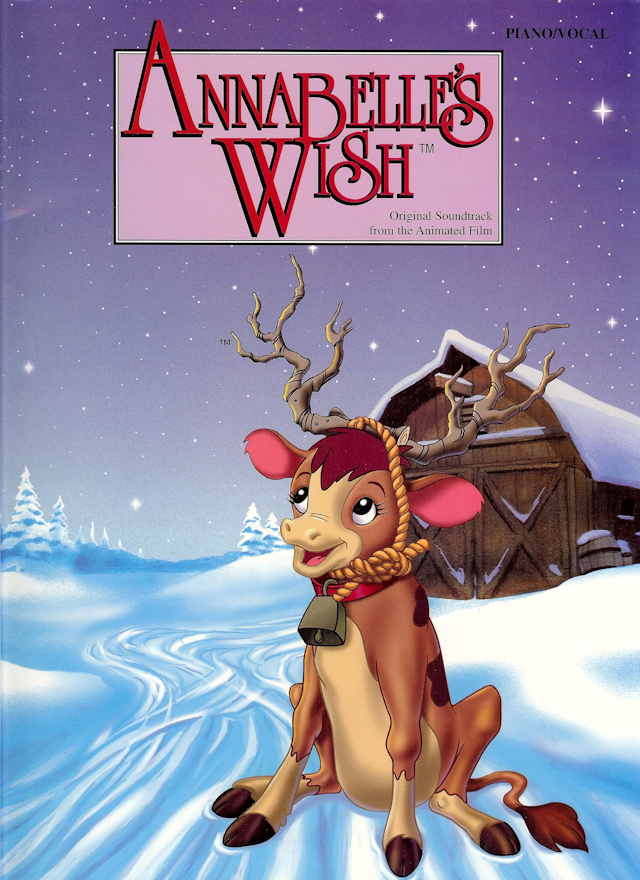 Although Truth or Consequences and This Is Your Life had both been parodied in cartoons, only one animated production has come from
Edwards' company - the children's Christmas special Annabelle's Wish, which first aired on Fox in 1997 and has since been shown on
the Fox Family and ABC Family cable channels, as well as being available on video and DVD. Country great Randy Travis provided the
narration and much of the music, and was joined by the voices of Jerry Van Dyke, Rue McClanahan, Jim Varney, and Cloris Leachman.
Annabelle's Wish received the 1997 Best Children's Video Award from the Video Software Dealers Association.
Although Truth or Consequences and This Is Your Life had both been parodied in cartoons, only one animated production has come from
Edwards' company - the children's Christmas special Annabelle's Wish, which first aired on Fox in 1997 and has since been shown on
the Fox Family and ABC Family cable channels, as well as being available on video and DVD. Country great Randy Travis provided the
narration and much of the music, and was joined by the voices of Jerry Van Dyke, Rue McClanahan, Jim Varney, and Cloris Leachman.
Annabelle's Wish received the 1997 Best Children's Video Award from the Video Software Dealers Association.
Even when he didn't have the weekly platform provided by TIYL, Edwards continued his attention to philanthropic work. Long actively
involved with the American Cancer Society, he was their 1963 National Crusade Chairman. Many other charitable and civic organizations
would benefit from his support over the years. The American Heart Association recognized his contributions by awarding Edwards their
first Honorary Life Membership in 1971. He would go on to act as Chairman of the National Easter Seals Society 1973, and was Honorary
Chairman of the Federal Savings Bond Drive in 1976. He later worked tirelessly for the American Parkinson's Disease Association,
dedicated to combating the disease that would take his wife Barbara in 1993.
When Ralph Edwards set out for New York in 1936, he wasn't sure if it would be radio or the stage where he would make his mark, and
acting was a life-long calling. His first screen appearance was an uncredited role in the 1937 all-star musical revue Manhattan
Merry-Go-Round. He appeared as himself in the wartime musical comedy Seven Days' Leave with Victor Mature and Lucille Ball in 1942,
as well as in 1945's Radio Stars on Parade with comedians Wally Brown and Alan Carney, Sheldon Leonard, and singer Frances Langford.
Edwards actually got the opportunity to play characters in two more Frances Langford vehicles, The Bamboo Blonde in 1946 and Beat the
Band in 1947 (which also featured drummer Gene Krupa). His last film appearance was in the 1955 bio-pic I'll Cry Tomorrow. Based on
the Lillian Roth autobiography, the film ends with her appearance on This Is Your Life.
Edwards and his productions have long been recognized for excellence. His four Emmys include two for TIYL and the Academy of
Television Arts and Sciences Lifetime Achievement Award in 2001. TIYL also received a Golden Globe in 1957. When the Hollywood
Walk of Fame was created in 1960, Edwards was among the initial group enshrined and was awarded two stars - one for radio, one for
TV. He was inducted into the National Broadcasters Hall of Fame in 1980, saluted by the New York Museum of Television and Radio in
1992, and inducted into the Radio Hall of Fame at the Museum of Broadcast Communications in Chicago in 1995. Edwards received the
George Washington Honor Medal from Freedoms Foundation at Valley Forge in 1985, and the Hollywood Chamber of Commerce Lifetime
Achievement Award in 2001. In 2004 he was the first recipient of the Game Show Congress Career Community Service Award, henceforth
to be known as the Ralph Edwards Career Community Service Award.
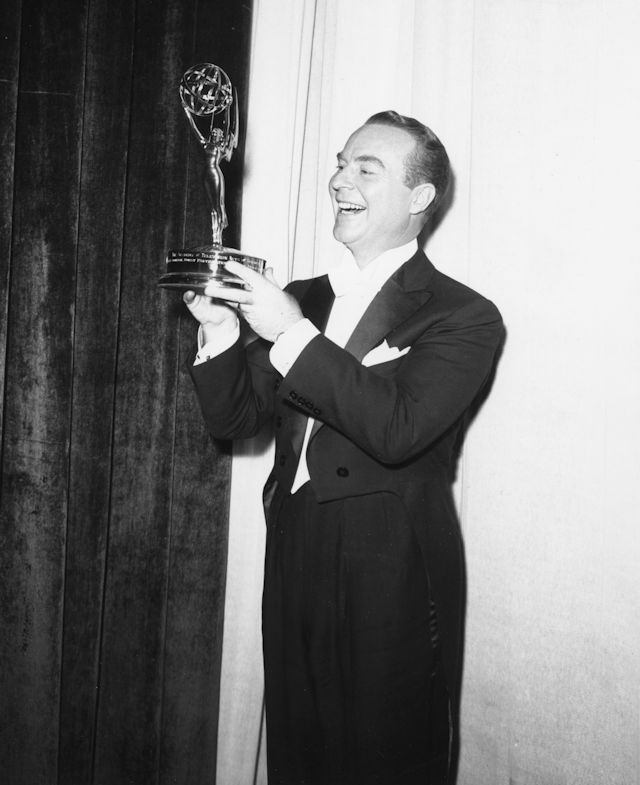 Edwards and his productions have long been recognized for excellence. His four Emmys include two for TIYL and the Academy of Television
Arts and Sciences Lifetime Achievement Award in 2001. TIYL also received a Golden Globe in 1957. When the Hollywood Walk of Fame
was created in 1960, Edwards was among the initial group enshrined and was awarded two stars - one for radio, one for TV. He was
inducted into the National Broadcasters Hall of Fame in 1980, saluted by the New York Museum of Television and Radio in 1992, and
inducted into the Radio Hall of Fame at the Museum of Broadcast Communications in Chicago in 1995. Edwards received the George
Washington Honor Medal from Freedoms Foundation at Valley Forge in 1985, and the Hollywood Chamber of Commerce Lifetime Achievement
Award in 2001. In 2004 he was the first recipient of the Game Show Congress Career Community Service Award, henceforth to be known
as the Ralph Edwards Career Community Service Award.
Edwards and his productions have long been recognized for excellence. His four Emmys include two for TIYL and the Academy of Television
Arts and Sciences Lifetime Achievement Award in 2001. TIYL also received a Golden Globe in 1957. When the Hollywood Walk of Fame
was created in 1960, Edwards was among the initial group enshrined and was awarded two stars - one for radio, one for TV. He was
inducted into the National Broadcasters Hall of Fame in 1980, saluted by the New York Museum of Television and Radio in 1992, and
inducted into the Radio Hall of Fame at the Museum of Broadcast Communications in Chicago in 1995. Edwards received the George
Washington Honor Medal from Freedoms Foundation at Valley Forge in 1985, and the Hollywood Chamber of Commerce Lifetime Achievement
Award in 2001. In 2004 he was the first recipient of the Game Show Congress Career Community Service Award, henceforth to be known
as the Ralph Edwards Career Community Service Award.
Ralph Edwards passed away on November 16, 2005, leaving a rich legacy. But perhaps the greatest tribute is the simple fact that for
70 years, there was at least one Ralph Edwards production on television.
|
|